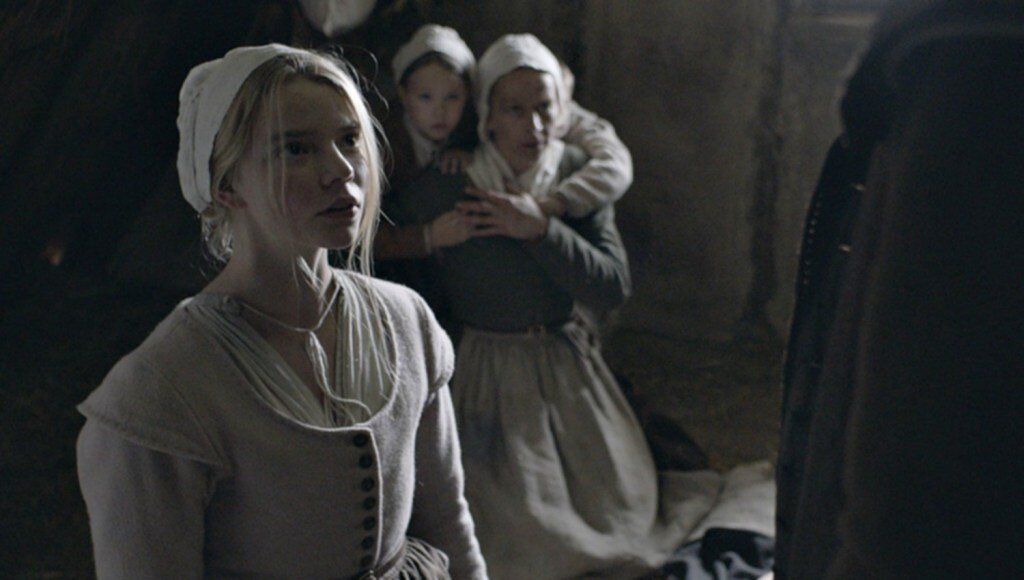Gendered Monstrousness in Eggers’ The VVitch
The first time we hear Thomasin’s voice in Robert Eggers’ The Witch (2015), she is praying, speaking aloud her confession, enumerating her sins. She has been idle at her work. She disobeyed her parents. She made merry on the Sabbath. And, she adds, she has broken all the Commandments in thought. Her prayer is intercut with scenes of life on the small farm that her family has carved out of the frontier. The dense woods that stand behind the homestead loom in each shot, visible out the window as she makes candles while her mother breastfeeds the baby, surrounding the father and sons as they harvest corn in the small field. The woods are a constant, oppressive presence—immense, unfathomable, the source of threats both known (wolves) and unknown (…everything else).
Thomasin denies her siblings’ accusations of witchcraft. (The Witch, dir. Robert Eggers, 2015)
It’s a similar danger to the one posed by the young Thomasin, who, as her mother describes (or—more aptly—accuses), “hath got the sign of her womanhood.” In her pubescence, Thomasin becomes more closely aligned with those mysterious woods—unknowable, uncontrollable, fecund, and dangerous. This onset of menses is especially troubling for an isolated family of Puritans, who viewed menstruation as a marker of and punishment for Eve’s Original Sin. (The name Thomasin itself, with its final syllable -sin, is a constant reminder of her impurity.) Thomasin’s developing body—already inciting lustful glances from her younger brother Caleb—is inherently understood as a problem, one that her mother intends to sell into service to another family. The woods–and what they contain–are not a problem so easily solved.
Although The Witch is often lauded as a feminist horror film, there is a relentless ambiguity in its stance toward women that makes me hesitate to agree. Thomasin is certainly the protagonist, and her perspective is privileged in the narrative, yet she is afforded no agency whatsoever. The film directly addresses feminist concerns about the religious opprobrium of women (particularly in Puritan orthodoxy), the inherent threat that patriarchal family structures pose to women, and the ways that those structures create suspicion and toxicity between women. But Eggers’ central concern is the way that women are bound up with constructions of monstrousness, and although he interrogates this phenomenon, the film stops shy of offering a rebuttal to the “natural” association of the abject with the female body.
Instead, the film seems to suggest that the only way to conceive of or to represent womanhood and femininity is through monstrous metaphor. We see this in how Katharine’s grief over her lost sons is sublimated through her fantasy of breastfeeding her child when it is really a raven making a bloody ruin of her breast; it fuels Katharine’s fury that causes her to strike William. We also see this monstrousness manifest in how Katharine relentlessly casts blame upon Thomasin—for the stolen infant, the purloined silver cup, and, although it is not spoken aloud, for the threat of her arousing Caleb’s sexual curiosity in the absence of any other target. The witch—who, in the film’s ambiguous depiction, may or may not actually exist—is an extension of these anxieties within the family. The witch—already what Barbara Creed describes as an “ancient figure of abjection”—perverts motherhood by sacrificing an infant instead of nurturing it, boldly seduces Caleb rather than inadvertently arousing his desire, and utterly rejects the symbolic order by refusing God (46). The witch is a textbook abjected figure—one who ruptures the systems of signification, who violates borders both geographic and bodily, who adorns herself with the blood of a corpse, who sexually gratifies herself with her blood and viscera-covered staff—one who transgresses every stricture with which Puritanism orders its world.
Yet Thomasin’s induction into the coven of witches at the end of the film feels less like the feminist triumph of her repudiation of Puritanical control and more like the only viable option left for her, a young woman whose family is dead, who is left without livestock on the edge of the frontier facing isolation and starvation. When she accepts Black Philip’s offer to “live deliciously,” it seems less a moment of transcendence and instead one of desperation. The majority of the film dwells on the ways womanhood is seen as permeable, polluted, monstrous; when Thomasin is left with no viable choice but to join the coven and become the literal abject figure instead of merely the metaphorically abjected figure, it feels less triumphant and more wretched.
Works Cited
Creed, Barbara. “Horror and the Monstrous-Feminine: An Imaginary Abjection.” Screen, vol. 27, no. 1, 1986, pp. 44-71.
Eggers, Robert, dir. The Witch. Performances by Anya-Taylor Joy, Ralph Ineson, and Kate Dickie, A24, 2015.
